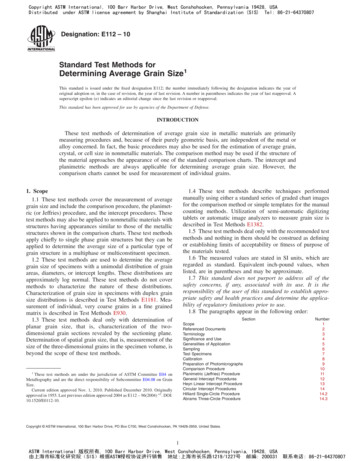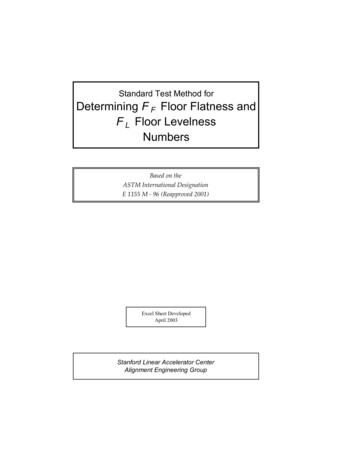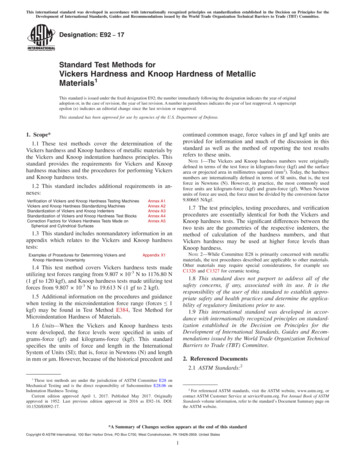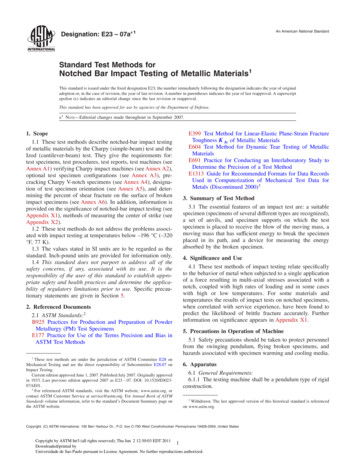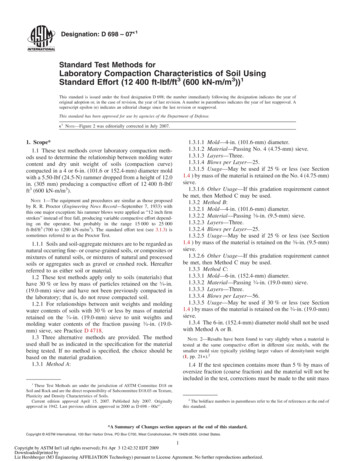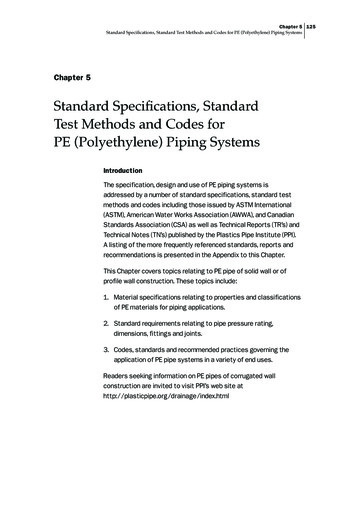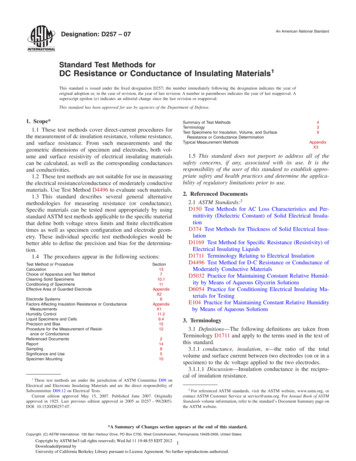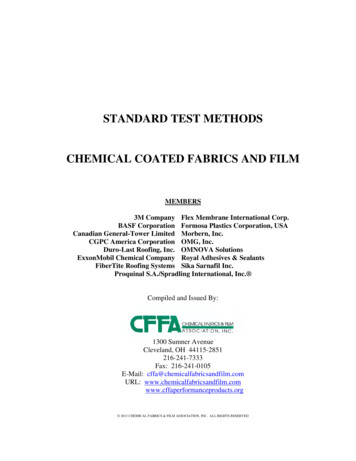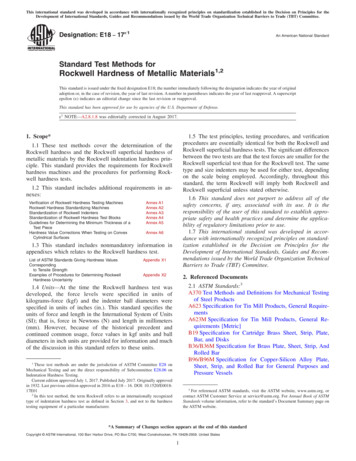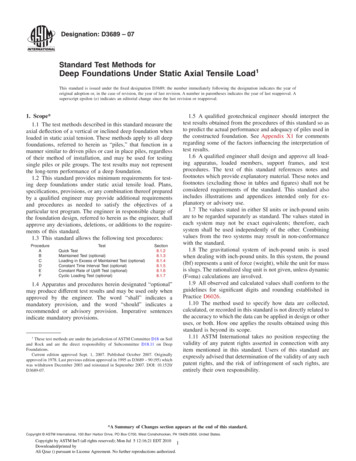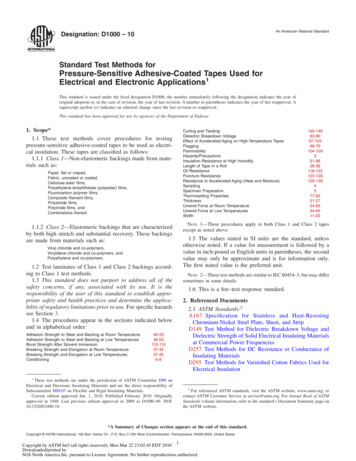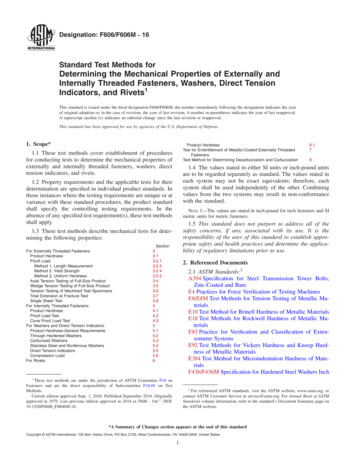
Transcription
Designation: F606/F606M 16Standard Test Methods forDetermining the Mechanical Properties of Externally andInternally Threaded Fasteners, Washers, Direct TensionIndicators, and Rivets1This standard is issued under the fixed designation F606/F606M; the number immediately following the designation indicates the yearof original adoption or, in the case of revision, the year of last revision. A number in parentheses indicates the year of last reapproval.A superscript epsilon ( ) indicates an editorial change since the last revision or reapproval.This standard has been approved for use by agencies of the U.S. Department of Defense.1. Scope*Product HardnessTest for Embrittlement of Metallic-Coated Externally ThreadedFastenersTest Method for Determining Decarburization and Carburization1.1 These test methods cover establishment of proceduresfor conducting tests to determine the mechanical properties ofexternally and internally threaded fasteners, washers, directtension indicators, and rivets.81.4 The values stated in either SI units or inch-pound unitsare to be regarded separately as standard. The values stated ineach system may not be exact equivalents; therefore, eachsystem shall be used independently of the other. Combiningvalues from the two systems may result in non-conformancewith the standard.1.2 Property requirements and the applicable tests for theirdetermination are specified in individual product standards. Inthose instances where the testing requirements are unique or atvariance with these standard procedures, the product standardshall specify the controlling testing requirements. In theabsence of any specified test requirement(s), these test methodsshall apply.NOTE 1—The values are stated in inch-pound for inch fasteners and SImetric units for metric fasteners.1.5 This standard does not purport to address all of thesafety concerns, if any, associated with its use. It is theresponsibility of the user of this standard to establish appropriate safety and health practices and determine the applicability of regulatory limitations prior to use.1.3 These test methods describe mechanical tests for determining the following properties:For Externally Threaded Fasteners:Product HardnessProof LoadMethod 1, Length MeasurementMethod 2, Yield StrengthMethod 3, Uniform HardnessAxial Tension Testing of Full-Size ProductWedge Tension Testing of Full-Size ProductTension Testing of Machined Test SpecimensTotal Extension at Fracture TestSingle Sheer TestFor Internally Threaded Fasteners:Product HardnessProof Load TestCone Proof Load TestFor Washers and Direct Tension Indicators:Product Hardness-General RequirementsThrough Hardened WashersCarburized WashersStainless Steel and Nonferrous WashersDirect Tension IndicatorsCompression LoadFor 63.73.844.14.24.355.15.25.35.45.55.662. Referenced Documents2.1 ASTM Standards:2A394 Specification for Steel Transmission Tower Bolts,Zinc-Coated and BareE4 Practices for Force Verification of Testing MachinesE8/E8M Test Methods for Tension Testing of Metallic MaterialsE10 Test Method for Brinell Hardness of Metallic MaterialsE18 Test Methods for Rockwell Hardness of Metallic MaterialsE83 Practice for Verification and Classification of Extensometer SystemsE92 Test Methods for Vickers Hardness and Knoop Hardness of Metallic MaterialsE384 Test Method for Microindentation Hardness of MaterialsF436/F436M Specification for Hardened Steel Washers Inch1These test methods are under the jurisdiction of ASTM Committee F16 onFasteners and are the direct responsibility of Subcommittee F16.01 on TestMethods.Current edition approved Sept. 1, 2016. Published September 2016. Originallyapproved in 1979. Last previous edition approved in 2014 as F606 – 14aɛ1. DOI:10.1520/F0606 F0606M-16.2For referenced ASTM standards, visit the ASTM website, www.astm.org, orcontact ASTM Customer Service at service@astm.org. For Annual Book of ASTMStandards volume information, refer to the standard’s Document Summary page onthe ASTM website.*A Summary of Changes section appears at the end of this standardCopyright ASTM International, 100 Barr Harbor Drive, PO Box C700, West Conshohocken, PA 19428-2959. United States1
F606/F606M 163.1.1.2 For studs, products without parallel wrench flats andfor head styles other than hex and square; tests shall beconducted on the unthreaded shank, end of the bolt or stud orat the arbitration location.3.1.1.3 Stress relieved products (3.1.1.1 and 3.1.1.2) aremeasured anywhere on the surface or through the cross section.Refer to the product specification for particular test location oruse the arbitration location.3.1.1.4 The Rockwell Hardness Scale may be used for allproduct diameters; however, the Brinell hardness is limited toproducts over 11 2-in. or M36.3.1.2 Laboratory Inspection—A minimum of three readingsshall be taken on each sample of finished product.3.1.3 Arbitration Test Location—For purposes of arbitrationbetween the purchaser and seller over reported test results,hardness tests shall be conducted at the mid-radius (r/2) of atransverse section through the threads taken at a distance ofapproximately one diameter from the point end of the bolt orone end of the stud. Four readings shall be taken from the pointend of the bolt or one end of the stud. Four readings shall betaken approximately 90 to one another on the same plane, ifproduct size permits. Smaller diameter products may also usethe opposite parallel surface area of the bolt head end assectioned above (see Fig. 1). The use of Brinell hardness forarbitration testing is limited to product sizes greater than21 4-in. or M60.and Metric DimensionsF959 Specification for Compressible-Washer-Type DirectTension Indicators for Use with Structural FastenersF1624 Test Method for Measurement of Hydrogen Embrittlement Threshold in Steel by the Incremental StepLoading TechniqueF2328 Test Method for Determining Decarburization andCarburization in Hardened and Tempered Threaded SteelBolts, Screws, Studs, and NutsF2328M Test Method for Determining Decarburization andCarburization in Hardened and Tempered Threaded SteelBolts, Screws, Studs, and Nuts (Metric)2.2 Military Standard:3MIL STD 1312, Test 13 and Test 203. Test Methods for Externally Threaded Fasteners3.1 Product Hardness—Tests shall be conducted after theremoval of any surface oxide, decarburization, plating or othercoating. All readings shall be within the hardness values listedin the product specification. The average of all readings on thesame part shall be considered as the product hardness. Testresults shall conform to the product specification for the lotrepresented by the test specimens to be considered conforming.Test specimen preparation and hardness tests shall be conducted in accordance with Test Methods E18 for Rockwelltests, Test Method E10 for Brinell tests, Test Method E92 forVickers tests, or Test Method E384 for Microhardness tests.The method used is at the option of the manufacturer, withregards to the size and grade of the products.3.1.1 Routine Test Locations—For testing the hardness ofthe finished product, the following test locations can be used:3.1.1.1 For hex and square head bolts; test shall be conducted on the wrench flats, top of head, unthreaded shank, endof bolt or at the arbitration location.3.2 Tension Tests—It is preferred that bolts and studs betested full size, and it is customary, when so testing, to specifya minimum ultimate load (or stress) in pounds-force (orpounds-force per square inch.) for inch fasteners and or load innewtons-force or megapascals MPa for metric fasteners. Sections 3.2 – 3.5 apply when testing externally threaded fastenersfull size. Section 3.6 shall apply where the individual productspecifications permit the use of machined specimens (see TestMethods E8/E8M).3.2.1 Proof Load—The proof-load test consists of stressingthe product with a specified load that the product mustwithstand without measurable permanent set. Alternative tests3DLA Document Services Building 4/D 700 Robbins Avenue Philadelphia, PA19111-5094 http://quicksearch.dla.mil/FIG. 1 Hardness Arbitration Test Location2
F606/F606M 16fasteners shall be allowed (for measurement error only) between the measurement made before loading and that madeafter loading. Variables such as straightness, thread alignment,or measurement error could result in apparent elongation of theproduct when the specified proof load is initially applied. Insuch cases, the product may be retested using a 3 % greaterload, and shall be considered acceptable if there is no difference in the length measurement after this loading within a0.0005 in. for inch fasteners and 6 0.013 mm for metricfasteners, measurement tolerance as outlined.3.2.4 Method 2, Yield Strength—Assemble the product inthe testing equipment as outlined in 3.4. As the load is applied,measure and record the total elongation of the product or anypart of it that includes the exposed threads to produce aload-elongation diagram. Determine the load or stress at anoffset equal to 0.2 % of the length of bolt occupied by six fullthreads as shown in Fig. 2 (except for heavy hex structuralbolts, which shall be based on four threads) by the methoddescribed in 3.6.3.1.3.2.4.1 Method 2A, Yield Strength for Austenitic StainlessSteel and Non-ferrous Materials—Assemble the product in thetesting equipment as outlined in 3.4. As the load is applied,measure and record the total elongation of the product in orderto produce a load elongation diagram. Determine the load orstress at an offset equal to 0.2 % strain based on the length ofthe bolt between the holders as shown in Fig. 2, which will besubject to elongation under load by using the method describedin 3.6.3.1.3.2.5 Method 3, Uniform Hardness—The fasteners shall betested for hardness as described in 3.1, and in addition, thehardness shall also be determined in the core. The differencebetween the mid-radius and core hardness shall be not morethan 3 points on a Rockwell C Scale; and both readings mustbe within product specification. This test is valid for fastenersup to and including 1 in. for inch fasteners and M24 diameterfor metric fasteners.for determining the ability of a fastener to pass the proof-loadtest are the yield strength test and the uniform hardness test.Either Method 1 (3.2.3), Method 2 (3.2.4), or Method 3 (3.2.5)may be used, but Method 1 shall be the arbitration method incase of any dispute as to acceptance of the product (see TestMethods E8/E8M).3.2.2 In both Methods 1 and 2, assemble the product in thefixture of the tension testing machine so that six completethreads (except for heavy hex structural bolts, which shall bebased on four threads) are exposed between the grips. This isobtained by freely running the nut or fixture to the threadrunout of the specimen and then unscrewing the specimen sixfull turns. For continuous thread bolts, at least six full threadsshall be exposed between the fixture ends; however, for refereepurposes, six full threads shall be exposed.3.2.3 Method 1, Length Measurement—To ensure consistentand repetitive length measurements of the fastener, thethreaded end and top of the bolt head shall have conicaldepressions made at the approximate axis or center line of thefastener. In the event of a dispute over test results the test shallbe conducted after the removal of all manufacturer or grademarkings, surface oxide, decarburization, plating, othercoating, or a combination thereof, to achieve a clean, flatsurface and the conical depressions shall be created using alathe or some type of centering fixture. All debris shall beremoved from the conical depressions before measuring thepart. When fasteners are too long to test in the availableequipment the fastener may be cut to 8 inches 6 0.125 for inchfasteners or a length of 200 mm 6 3.0 mm for metric fastenersand tested using Method 1. If there is a dispute over resultswhen testing the same part or lot of parts, both full size and cutfastener the cut fastener results shall be used to determineacceptance. The measuring instrument shall have pointedanvils which mate with the center line depressions and becapable of measuring changes in length of 0.0001 in. for inchfasteners and 0.0025 mm for metric fasteners. The instrumentaccuracy shall be within 0.0001 in. in any 0.001 in. range forinch parts and within 0.0025 mm accuracy within any 0.025mm range for metric parts. Place the fastener between themeasuring anvils. The fastener shall be rotated at least 360degrees to assure sound seating. At the position where thelowest value is indicated the instrument shall be zeroed or theindicated measurement shall be recorded. If using a boltextensometer, the bolt with attached extensometer may beassembled into the tension testing machine. If not, mark thefastener so it may be placed as close as possible to the sameposition for the second reading. Remove and assemble thefastener into the tension testing machine as outlined in 3.4.With a test speed which shall not exceed 0.12 in./min for inchfasteners and 3.0 mm/min for metric fasteners, as determinedwith a free-running cross head, axially load the fastener to theproof load value specified in the product specification. Thisload shall be maintained for a period of 10 s before releasingthe load. Replace the fastener between the measuring anvilsand rotate at least 360 degrees as before. The fastener shall bestopped at the position where the lowest value is indicated. Themeasurement shall show no permanent elongation. A toleranceof 60.0005 in. for inch fasteners and 6 0.013 mm for metric3.3 Bolts or Studs Too Short for Tension Testing—Productlengths less than those shown in Table 1 for product 1 4 through3 4 in. for inch fasteners and M5 through M20 for metricfasteners in diameter and less than three diameters in length forproduct above 3 4 in. and M20 in diameter, or that do not havesufficient threads for proper engagement and still leave thes
2.1 ASTM Standards:2 A394 Specification for Steel Transmission Tower Bolts, Zinc-Coated and Bare E4 Practices for Force Verification of Testing Machines E8/E8M Test Methods for Tension Testing of Metallic Ma-terials E10 Test Method for Brinell Hardness of Metallic Materials E18 Test Methods for Rockwell Hardness of Metallic Ma-terials
